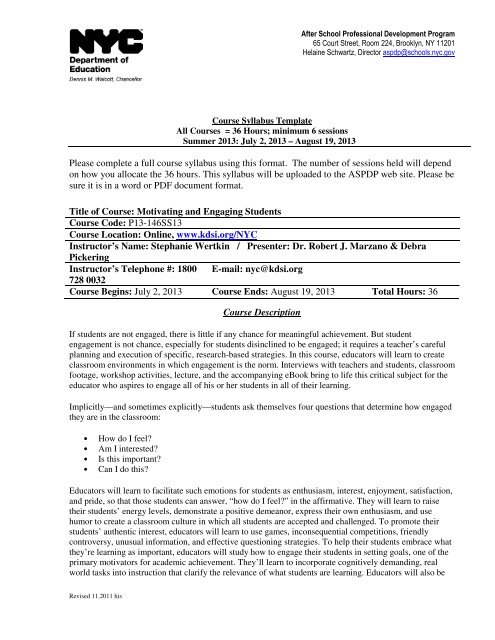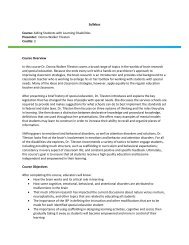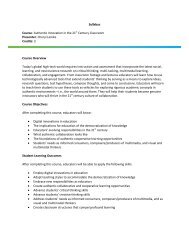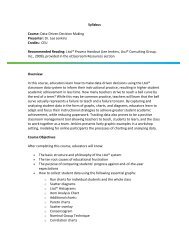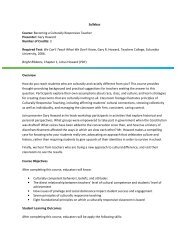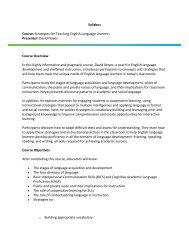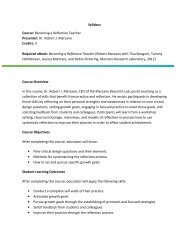Please complete a full course syllabus using this format. The ...
Please complete a full course syllabus using this format. The ...
Please complete a full course syllabus using this format. The ...
Create successful ePaper yourself
Turn your PDF publications into a flip-book with our unique Google optimized e-Paper software.
After School Professional Development Program65 Court Street, Room 224, Brooklyn, NY 11201Helaine Schwartz, Director aspdp@schools.nyc.govCourse Syllabus TemplateAll Courses = 36 Hours; minimum 6 sessionsSummer 2013: July 2, 2013 – August 19, 2013<strong>Please</strong> <strong>complete</strong> a <strong>full</strong> <strong>course</strong> <strong>syllabus</strong> <strong>using</strong> <strong>this</strong> <strong>format</strong>. <strong>The</strong> number of sessions held will dependon how you allocate the 36 hours. This <strong>syllabus</strong> will be uploaded to the ASPDP web site. <strong>Please</strong> besure it is in a word or PDF document <strong>format</strong>.Title of Course: Motivating and Engaging StudentsCourse Code: P13-146SS13Course Location: Online, www.kdsi.org/NYCInstructor’s Name: Stephanie Wertkin / Presenter: Dr. Robert J. Marzano & DebraPickeringInstructor’s Telephone #: 1800 E-mail: nyc@kdsi.org728 0032Course Begins: July 2, 2013 Course Ends: August 19, 2013 Total Hours: 36Course DescriptionIf students are not engaged, there is little if any chance for meaningful achievement. But studentengagement is not chance, especially for students disinclined to be engaged; it requires a teacher’s carefulplanning and execution of specific, research-based strategies. In <strong>this</strong> <strong>course</strong>, educators will learn to createclassroom environments in which engagement is the norm. Interviews with teachers and students, classroomfootage, workshop activities, lecture, and the accompanying eBook bring to life <strong>this</strong> critical subject for theeducator who aspires to engage all of his or her students in all of their learning.Implicitly—and sometimes explicitly—students ask themselves four questions that determine how engagedthey are in the classroom:• How do I feel?• Am I interested?• Is <strong>this</strong> important?• Can I do <strong>this</strong>?Educators will learn to facilitate such emotions for students as enthusiasm, interest, enjoyment, satisfaction,and pride, so that those students can answer, “how do I feel?” in the affirmative. <strong>The</strong>y will learn to raisetheir students’ energy levels, demonstrate a positive demeanor, express their own enthusiasm, and usehumor to create a classroom culture in which all students are accepted and challenged. To promote theirstudents’ authentic interest, educators will learn to use games, inconsequential competitions, friendlycontroversy, unusual in<strong>format</strong>ion, and effective questioning strategies. To help their students embrace whatthey’re learning as important, educators will study how to engage their students in setting goals, one of theprimary motivators for academic achievement. <strong>The</strong>y’ll learn to incorporate cognitively demanding, realworld tasks into instruction that clarify the relevance of what students are learning. Educators will also beRevised 11.2011 his
After School Professional Development Program65 Court Street, Room 224, Brooklyn, NY 11201Helaine Schwartz, Director aspdp@schools.nyc.govprepared to help their students develop strong feelings of self-efficacy, not through superfluous praise, butthrough making students aware of their potential futures, which they can affect through their own efforts.Motivating and engaging all students means finding ways to do so for African-American, Latino, and lowincomestudents as well as those students who may have had more benefits at home and are already moreintrinsically motivated. <strong>The</strong>se strategies will empower teachers to find ways of nurturing all their studentsand help them assist in closing the achievement gap. Teachers trained in motivating and engaging studentswill be contributing to a culture of achievement for all students.NOTE: Midterms may be submitted anytime but are due no later than 2 weeks after the finalregistration date.CalendarSession # 1Date: self-pacedTime: self-pacedNumber of hours for <strong>this</strong> session: 1Topics: List session topic and material, e.g. handouts. Indicate midterm and final exam date.Setting Learning GoalsKDS has implemented a topic at the beginning of the <strong>course</strong>, Setting Learning Goals, that instructs participantsto read the <strong>syllabus</strong> that contains a <strong>course</strong> and unit descriptions and then to develop student learning goals relatedto the domains and components from Charlotte Danielson’s Framework for Teaching (athttp://charlottedanielson.com/theframeteach.htm). <strong>The</strong>y may also consult the NYC Teacher Effectiveness site (athttp://schools.nyc.gov/Academics/CommonCoreLibrary/Toolkit/TeacherEffectiveness/default.htm),and the NYC CCSS (athttp://schools.nyc.gov/Academics/CommonCoreLibrary/Why/NYSStandards/default.htm). (Participants may alsodraw from existing classroom data they have collected from pretests and assessments or know anecdotally.)Objectives: Specify instructional goals and standards for each session.Goal:• To set student learning goalsMethod of Instruction: List the method of presenting: Classroom video or interactive hands-on activity. Includestrategies to meet diverse learning needs (differentiated instruction).• Participants consult standards• Participants create learning goalsClassroom Practice: Specify what skills and strategies the participant will bring back to his/her classroom.• Participants bring their learning goals to their studentsResources (readings, artifacts, internet sites, videos, etc): Provide the title, author, edition, publisher, cost, andwhere it is available. If there is a guest speaker, include the presenter’s name and affiliation.• Charlotte Danielson’s Framework for Teaching (at http://charlottedanielson.com/theframeteach.htm).• NYC Teacher Effectiveness site (athttp://schools.nyc.gov/Academics/CommonCoreLibrary/Toolkit/TeacherEffectiveness/default.hRevised 11.2011 his
After School Professional Development Program65 Court Street, Room 224, Brooklyn, NY 11201Helaine Schwartz, Director aspdp@schools.nyc.govtm),• NYC CCSS (athttp://schools.nyc.gov/Academics/CommonCoreLibrary/Why/NYSStandards/default.htm). (Participantsmay also draw from existing classroom data they have collected from pretests andGuest Speakers:CalendarSession # 2Date: self-pacedTime: self-pacedNumber of hours for <strong>this</strong> session: 2.5Topics: List session topic and material, e.g. handouts. Indicate midterm and final exam date.Introduction and Overview of ResearchIn <strong>this</strong> unit, Marzano Research Laboratory CEO Robert Marzano and Senior Scholar DebraPickering present a model for attention and engagement that helps teachers get positive answersfrom their students in response to these critical questions: how do I feel? Am I interested? Is <strong>this</strong>important? And can I do <strong>this</strong>? <strong>The</strong>y review some key details about how memory works and theresearch that supports strategies that will facilitate students’ motivation, engagement, andachievement.Objectives: Specify instructional goals and standards for each session.After completing <strong>this</strong> unit, participants will know:• What questions students need to answer positively to be motivated and engaged• Research supporting relevant strategies• How memory worksA Framework for Teaching3c: Instruction: Engaging Students in LearningCommon Core State Standards in Literacy:Participants who success<strong>full</strong>y adapt <strong>this</strong> <strong>course</strong>’s strategies for motivating and engaging students will behelping their students to achieve the CCSS literacy standards. <strong>The</strong>y will, for example, diversify their choicesof texts, <strong>using</strong> more nonfiction examples that appeal to student interest. <strong>The</strong>y will also be promoting moredepth of knowledge in the disciplines and increasing text complexity in order to challenge students.Method of Instruction: List the method of presenting: Classroom video or interactive hands-on activity.Include strategies to meet diverse learning needs (differentiated instruction).• Video• Reflection promptsRevised 11.2011 his
After School Professional Development Program65 Court Street, Room 224, Brooklyn, NY 11201Helaine Schwartz, Director aspdp@schools.nyc.gov• Discussion forum• QuizClassroom Practice: Specify what skills and strategies the participant will bring back to his/her classroom.After completing <strong>this</strong> unit, participants will apply the following skills:• Recognize the need to address students’ emotions, interests, sense of the importance ofcontent, and sense of self-efficacyResources (readings, artifacts, internet sites, videos, etc): Provide the title, author, edition, publisher,cost, and where it is available. If there is a guest speaker, include the presenter’s name and affiliation.Guest Speakers:CalendarSession # 3Date: self-pacedTime: self-pacedNumber of hours for <strong>this</strong> session: 2.5Topics: List session topic and material, e.g. handouts. Indicate midterm and final exam date.eBook: ResearchParticipants read “Chapter 1: Research and <strong>The</strong>ory” in the eBook of <strong>The</strong> Highly EngagedClassroom and address relevant issues in a reflection question <strong>format</strong>. <strong>The</strong>y also participate in thediscussion forum.Objectives: Specify instructional goals and standards for each session.After completing <strong>this</strong> unit, participants will know:• What questions students need to answer positively to be motivated and engaged• Research supporting relevant strategies• How memory worksA Framework for Teaching3c: Instruction: Engaging Students in LearningCommon Core State Standards in Literacy:Participants who success<strong>full</strong>y adapt <strong>this</strong> <strong>course</strong>’s strategies for motivating and engaging students will behelping their students to achieve the CCSS literacy standards. <strong>The</strong>y will, for example, diversify their choicesof texts, <strong>using</strong> more nonfiction examples that appeal to student interest. <strong>The</strong>y will also be promoting moredepth of knowledge in the disciplines and increasing text complexity in order to challenge students.Revised 11.2011 his
After School Professional Development Program65 Court Street, Room 224, Brooklyn, NY 11201Helaine Schwartz, Director aspdp@schools.nyc.govMethod of Instruction: List the method of presenting: Classroom video or interactive hands-on activity.Include strategies to meet diverse learning needs (differentiated instruction).• eBook• Reflection prompts• Discussion forumClassroom Practice: Specify what skills and strategies the participant will bring back to his/her classroom.Resources (readings, artifacts, internet sites, videos, etc): Provide the title, author, edition, publisher,cost, and where it is available. If there is a guest speaker, include the presenter’s name and affiliation.• eBook (available through the eClassroom)Guest Speakers:CalendarSession # 4Date: self-pacedTime: self-pacedNumber of hours for <strong>this</strong> session: 2.5Topics: List session topic and material, e.g. handouts. Indicate midterm and final exam date.How Do I Feel?In <strong>this</strong> unit, expert presenters Robert Marzano and Debra Pickering detail why teachers need toaddress students’ emotions and strategies to do so. Discussion among workshop participants,interviews with teachers, and classroom footage illustrate the impact on students’ attention ofeffective pacing, physical movement, humor, a teacher’s own enthusiasm, and positiverelationships between teacher and students and student to student.Objectives: Specify instructional goals and standards for each session.After completing <strong>this</strong> unit, participants will know:• <strong>The</strong> role of emotions in student engagement• Strategies to help students answer positively the question, “how do I feel?”A Framework for Teaching3c: Instruction: Engaging Students in LearningCommon Core State Standards in Literacy:Participants who success<strong>full</strong>y adapt <strong>this</strong> <strong>course</strong>’s strategies for motivating and engaging students will behelping their students to achieve the CCSS literacy standards. <strong>The</strong>y will, for example, diversify their choicesof texts, <strong>using</strong> more nonfiction examples that appeal to student interest. <strong>The</strong>y will also be promoting moreRevised 11.2011 his
After School Professional Development Program65 Court Street, Room 224, Brooklyn, NY 11201Helaine Schwartz, Director aspdp@schools.nyc.govdepth of knowledge in the disciplines and increasing text complexity in order to challenge students.Method of Instruction: List the method of presenting: Classroom video or interactive hands-on activity.Include strategies to meet diverse learning needs (differentiated instruction).• Video• Reflection prompts• Discussion forum• QuizClassroom Practice: Specify what skills and strategies the participant will bring back to his/her classroom.After completing <strong>this</strong> unit, participants will apply the following skills:• Use effective pacing, physical movement, humor, enthusiasm, and positive relationships toaffect students’ engagement and motivationResources (readings, artifacts, internet sites, videos, etc): Provide the title, author, edition, publisher,cost, and where it is available. If there is a guest speaker, include the presenter’s name and affiliation.• eBook (available through the eClassroom)Guest Speakers:CalendarSession # 5Date: self-pacedTime: self-pacedNumber of hours for <strong>this</strong> session: 2.5Topics: List session topic and material, e.g. handouts. Indicate midterm and final exam date.eBook: EmotionsParticipants read “Chapter 2: How Do I Feel?” in the eBook of <strong>The</strong> Highly Engaged Classroom andaddress relevant issues in a reflection question <strong>format</strong>. <strong>The</strong>y also participate in the discussionforum.Objectives: Specify instructional goals and standards for each session.After completing <strong>this</strong> unit, participants will know:• <strong>The</strong> role of emotions in student engagement• Strategies to help students answer positively the question, “how do I feel?”A Framework for Teaching3c: Instruction: Engaging Students in LearningCommon Core State Standards in Literacy:Revised 11.2011 his
After School Professional Development Program65 Court Street, Room 224, Brooklyn, NY 11201Helaine Schwartz, Director aspdp@schools.nyc.govParticipants who success<strong>full</strong>y adapt <strong>this</strong> <strong>course</strong>’s strategies for motivating and engaging students will behelping their students to achieve the CCSS literacy standards. <strong>The</strong>y will, for example, diversify their choicesof texts, <strong>using</strong> more nonfiction examples that appeal to student interest. <strong>The</strong>y will also be promoting moredepth of knowledge in the disciplines and increasing text complexity in order to challenge students.Method of Instruction: List the method of presenting: Classroom video or interactive hands-on activity.Include strategies to meet diverse learning needs (differentiated instruction).• eBook• reflection prompts• discussion forumClassroom Practice: Specify what skills and strategies the participant will bring back to his/her classroom.After completing <strong>this</strong> unit, participants will apply the following skills:• Use effective pacing, physical movement, humor, enthusiasm, and positive relationships toaffect students’ engagement and motivationResources (readings, artifacts, internet sites, videos, etc): Provide the title, author, edition, publisher,cost, and where it is available. If there is a guest speaker, include the presenter’s name and affiliation.Guest Speakers:CalendarSession # 6Date: self-pacedTime: self-pacedNumber of hours for <strong>this</strong> session: 2.5Topics: List session topic and material, e.g. handouts. Indicate midterm and final exam date.Am I Interested?In <strong>this</strong> unit, Marzano and Pickering explore ways to help students answer “yes” to “Am Iinterested?” <strong>The</strong>y, their workshop members, and teachers and students in real classrooms illustratethe impact of games and other inconsequential competition, friendly controversy, unusual orintriguing in<strong>format</strong>ion, and effective questioning techniques that leave no students unengaged.Objectives: Specify instructional goals and standards for each session.After completing <strong>this</strong> unit, participants will know:• <strong>The</strong> role of student interest in student engagement• Strategies to help students answer positively the question, “am I interested?”A Framework for Teaching3c: Instruction: Engaging Students in LearningRevised 11.2011 his
After School Professional Development Program65 Court Street, Room 224, Brooklyn, NY 11201Helaine Schwartz, Director aspdp@schools.nyc.govCommon Core State Standards in Literacy:Participants who success<strong>full</strong>y adapt <strong>this</strong> <strong>course</strong>’s strategies for motivating and engaging students will behelping their students to achieve the CCSS literacy standards. <strong>The</strong>y will, for example, diversify their choicesof texts, <strong>using</strong> more nonfiction examples that appeal to student interest. <strong>The</strong>y will also be promoting moredepth of knowledge in the disciplines and increasing text complexity in order to challenge students.Method of Instruction: List the method of presenting: Classroom video or interactive hands-on activity.Include strategies to meet diverse learning needs (differentiated instruction).• Video• Reflection prompts• Discussion forum• QuizClassroom Practice: Specify what skills and strategies the participant will bring back to his/her classroom.After completing <strong>this</strong> unit, participants will apply the following skills:• Use games and other inconsequential competition, friendly controversy, unusual orintriguing in<strong>format</strong>ion, and effective questioning techniques to stimulate their students’engagementResources (readings, artifacts, internet sites, videos, etc): Provide the title, author, edition, publisher,cost, and where it is available. If there is a guest speaker, include the presenter’s name and affiliation.Guest Speakers:CalendarSession # 7Date: self-pacedTime: self-pacedNumber of hours for <strong>this</strong> session: 5Topics: List session topic and material, e.g. handouts. Indicate midterm and final exam date.MidtermTwo critical questions students must answer in the affirmative in order to be engaged in their learning are“how do I feel?” and “am I interested?” Develop an activity related to specific content that you think willfacilitate students’ positive feelings and interest. Your activity should be supported by the research, haveclear objectives, and incorporate Dr. Robert J. Marzano’s and Debra Pickering’s classroom strategies.<strong>Please</strong> do the following:1. State your activity’s learning objectives.2. Describe how you will assess the project in relation to those objectives.Revised 11.2011 his
After School Professional Development Program65 Court Street, Room 224, Brooklyn, NY 11201Helaine Schwartz, Director aspdp@schools.nyc.gov3. Detail the steps of the activity, ensuring that they are aligned to your assessments, and makingclear which of the presenters’ strategies you are incorporating.4. Explain how the activity aligns with the research.5. Write a reflection addressing the following:a. How will you know that your students are answering in the affirmative to “how do I feel?”What evidence do you expect to see?b. How will you know that your students are interested? Again, what evidence do you expectto see?6. Implement the activity in your classroom (required for the Final).Objectives: Specify instructional goals and standards for each session.Method of Instruction: List the method of presenting: Classroom video or interactive hands-on activity.Include strategies to meet diverse learning needs (differentiated instruction).Classroom Practice: Specify what skills and strategies the participant will bring back to his/her classroom.Resources (readings, artifacts, internet sites, videos, etc): Provide the title, author, edition, publisher,cost, and where it is available. If there is a guest speaker, include the presenter’s name and affiliation.Guest Speakers:CalendarSession # 8Date: self-pacedTime: self-pacedNumber of hours for <strong>this</strong> session: 2.5Topics: List session topic and material, e.g. handouts. Indicate midterm and final exam date.eBook: InterestParticipants read “Chapter 3: Am I Interested?” in the eBook of <strong>The</strong> Highly Engaged Classroomand address relevant issues in a reflection question <strong>format</strong>. <strong>The</strong>y also participate in the discussionforum.Objectives: Specify instructional goals and standards for each session.After completing <strong>this</strong> unit, participants will know:• <strong>The</strong> role of student interest in student engagement• Strategies to help students answer positively the question, “am I interested?”A Framework for Teaching3c: Instruction: Engaging Students in LearningCommon Core State Standards in Literacy:Revised 11.2011 his
After School Professional Development Program65 Court Street, Room 224, Brooklyn, NY 11201Helaine Schwartz, Director aspdp@schools.nyc.govParticipants who success<strong>full</strong>y adapt <strong>this</strong> <strong>course</strong>’s strategies for motivating and engaging students will behelping their students to achieve the CCSS literacy standards. <strong>The</strong>y will, for example, diversify their choicesof texts, <strong>using</strong> more nonfiction examples that appeal to student interest. <strong>The</strong>y will also be promoting moredepth of knowledge in the disciplines and increasing text complexity in order to challenge students.Method of Instruction: List the method of presenting: Classroom video or interactive hands-on activity.Include strategies to meet diverse learning needs (differentiated instruction).• eBook• Reflection prompts• Discussion forumClassroom Practice: Specify what skills and strategies the participant will bring back to his/her classroom.After completing <strong>this</strong> unit, participants will apply the following skills:• Use games and other inconsequential competition, friendly controversy, unusual orintriguing in<strong>format</strong>ion, and effective questioning techniques to stimulate their students’engagementResources (readings, artifacts, internet sites, videos, etc): Provide the title, author, edition, publisher,cost, and where it is available. If there is a guest speaker, include the presenter’s name and affiliation.• eBook (available through the eClassroom)Guest Speakers:CalendarSession # 9Date: self-pacedTime: self-pacedNumber of hours for <strong>this</strong> session: 2.5Topics: List session topic and material, e.g. handouts. Indicate midterm and final exam date.Is This Important?In <strong>this</strong> unit, Marzano and Pickering focus their attention on how teachers can make their contentrelevant to their students’ lives in the present and to their short- and long-term ambitions. <strong>The</strong>ydetail such strategies as personal projects that invite students to articulate and pursue goals and howto make tasks cognitively complex to the degree that students are absorbed by them. Interviews,workshop discussion, and classroom footage translate theory into practice.Objectives: Specify instructional goals and standards for each session.After completing <strong>this</strong> unit, participants will know:• <strong>The</strong> role of importance in student engagement• Strategies to help students answer positively the question, “is <strong>this</strong> important?”Revised 11.2011 his
After School Professional Development Program65 Court Street, Room 224, Brooklyn, NY 11201Helaine Schwartz, Director aspdp@schools.nyc.govA Framework for Teaching3c: Instruction: Engaging Students in LearningCommon Core State Standards in Literacy:Participants who success<strong>full</strong>y adapt <strong>this</strong> <strong>course</strong>’s strategies for motivating and engaging students will behelping their students to achieve the CCSS literacy standards. <strong>The</strong>y will, for example, diversify their choicesof texts, <strong>using</strong> more nonfiction examples that appeal to student interest. <strong>The</strong>y will also be promoting moredepth of knowledge in the disciplines and increasing text complexity in order to challenge students.Method of Instruction: List the method of presenting: Classroom video or interactive hands-on activity.Include strategies to meet diverse learning needs (differentiated instruction).• Video• Reflection prompts• Discussion forum• QuizClassroom Practice: Specify what skills and strategies the participant will bring back to his/her classroom.After completing <strong>this</strong> unit, participants will apply the following skills:• Use personal projects, goal-oriented activities, and cognitively complex tasks to motivateand engage studentsResources (readings, artifacts, internet sites, videos, etc): Provide the title, author, edition, publisher,cost, and where it is available. If there is a guest speaker, include the presenter’s name and affiliation.Guest Speakers:CalendarSession # 10Date: self-pacedTime: self-pacedNumber of hours for <strong>this</strong> session: 2.5Topics: List session topic and material, e.g. handouts. Indicate midterm and final exam date.eBook: Lifelong GoalsParticipants read “Chapter 4: Is This Important” in the eBook of <strong>The</strong> Highly Engaged Classroomand address relevant issues in a reflection question <strong>format</strong>. <strong>The</strong>y also participate in the discussionforum.Objectives: Specify instructional goals and standards for each session.After completing <strong>this</strong> unit, participants will know:Revised 11.2011 his
After School Professional Development Program65 Court Street, Room 224, Brooklyn, NY 11201Helaine Schwartz, Director aspdp@schools.nyc.gov• <strong>The</strong> role of importance in student engagement• Strategies to help students answer positively the question, “is <strong>this</strong> important?”A Framework for Teaching3c: Instruction: Engaging Students in LearningCommon Core State Standards in Literacy:Participants who success<strong>full</strong>y adapt <strong>this</strong> <strong>course</strong>’s strategies for motivating and engaging students will behelping their students to achieve the CCSS literacy standards. <strong>The</strong>y will, for example, diversify their choicesof texts, <strong>using</strong> more nonfiction examples that appeal to student interest. <strong>The</strong>y will also be promoting moredepth of knowledge in the disciplines and increasing text complexity in order to challenge students.Method of Instruction: List the method of presenting: Classroom video or interactive hands-on activity.Include strategies to meet diverse learning needs (differentiated instruction).• eBook• Reflection prompts• Discussion forumClassroom Practice: Specify what skills and strategies the participant will bring back to his/her classroom.After completing <strong>this</strong> unit, participants will apply the following skills:• Use personal projects, goal-oriented activities, and cognitively complex tasks to motivateand engage studentsResources (readings, artifacts, internet sites, videos, etc): Provide the title, author, edition, publisher,cost, and where it is available. If there is a guest speaker, include the presenter’s name and affiliation.• eBook (available through the eClassroom)Guest Speakers:CalendarSession # 11Date: self-pacedTime: self-pacedNumber of hours for <strong>this</strong> session: 2.5Topics: List session topic and material, e.g. handouts. Indicate midterm and final exam date.Can I Do This?In <strong>this</strong> unit, Marzano and Pickering, et al, turn to the critical issue of self-efficacy in determiningstudent engagement. <strong>The</strong>y foreground ways to teach and otherwise promote students’ self-efficacyand to nurture a growth vs. a fixed mindset that renders students active participants in all theirRevised 11.2011 his
After School Professional Development Program65 Court Street, Room 224, Brooklyn, NY 11201Helaine Schwartz, Director aspdp@schools.nyc.govlearning.Objectives: Specify instructional goals and standards for each session.After completing <strong>this</strong> unit, participants will know:• <strong>The</strong> role of self-efficacy in student engagement• Strategies to help students answer positively the question, “can I do <strong>this</strong>?”A Framework for Teaching3c: Instruction: Engaging Students in LearningCommon Core State Standards in Literacy:Participants who success<strong>full</strong>y adapt <strong>this</strong> <strong>course</strong>’s strategies for motivating and engaging students will behelping their students to achieve the CCSS literacy standards. <strong>The</strong>y will, for example, diversify their choicesof texts, <strong>using</strong> more nonfiction examples that appeal to student interest. <strong>The</strong>y will also be promoting moredepth of knowledge in the disciplines and increasing text complexity in order to challenge students.Method of Instruction: List the method of presenting: Classroom video or interactive hands-on activity.Include strategies to meet diverse learning needs (differentiated instruction).• Video• Reflection prompts• Discussion forum• QuizClassroom Practice: Specify what skills and strategies the participant will bring back to his/her classroom.After completing <strong>this</strong> unit, participants will apply the following skills:• Promote students’ self-efficacy through strategies such as <strong>using</strong> effective feedback, directlyteaching self-efficacy and exploring with students the impact of self-efficacy—all of whichlead to increased motivation and engagementResources (readings, artifacts, internet sites, videos, etc): Provide the title, author, edition, publisher,cost, and where it is available. If there is a guest speaker, include the presenter’s name and affiliation.Guest Speakers:Session # 12Date: self-pacedNumber of hours for <strong>this</strong> session: 2.5CalendarTime: self-pacedRevised 11.2011 his
After School Professional Development Program65 Court Street, Room 224, Brooklyn, NY 11201Helaine Schwartz, Director aspdp@schools.nyc.govTopics: List session topic and material, e.g. handouts. Indicate midterm and final exam date.eBook: Self-efficacyParticipants read “Chapter 5: Can I Do This?” in the eBook of <strong>The</strong> Highly Engaged Classroom andaddress relevant issues in a reflection question <strong>format</strong>. <strong>The</strong>y also participate in the discussionforum.Objectives: Specify instructional goals and standards for each session.After completing <strong>this</strong> unit, participants will know:• <strong>The</strong> role of self-efficacy in student engagement• Strategies to help students answer positively the question, “can I do <strong>this</strong>?”A Framework for Teaching3c: Instruction: Engaging Students in LearningCommon Core State Standards in Literacy:Participants who success<strong>full</strong>y adapt <strong>this</strong> <strong>course</strong>’s strategies for motivating and engaging students will behelping their students to achieve the CCSS literacy standards. <strong>The</strong>y will, for example, diversify their choicesof texts, <strong>using</strong> more nonfiction examples that appeal to student interest. <strong>The</strong>y will also be promoting moredepth of knowledge in the disciplines and increasing text complexity in order to challenge students.Method of Instruction: List the method of presenting: Classroom video or interactive hands-on activity.Include strategies to meet diverse learning needs (differentiated instruction).• eBook• Reflection prompts• Discussion forumClassroom Practice: Specify what skills and strategies the participant will bring back to his/her classroom.After completing <strong>this</strong> unit, participants will apply the following skills:• Promote students’ self-efficacy through strategies such as <strong>using</strong> effective feedback, directlyteaching self-efficacy and exploring with students the impact of self-efficacy—all of whichlead to increased motivation and engagementResources (readings, artifacts, internet sites, videos, etc): Provide the title, author, edition, publisher,cost, and where it is available. If there is a guest speaker, include the presenter’s name and affiliation.• eBook (available through the eClassroom)Guest Speakers:Revised 11.2011 his
After School Professional Development Program65 Court Street, Room 224, Brooklyn, NY 11201Helaine Schwartz, Director aspdp@schools.nyc.govCalendarSession # 13Date: self-pacedTime: self-pacedNumber of hours for <strong>this</strong> session: 5Topics: List session topic and material, e.g. handouts. Indicate midterm and final exam date.FinalFor your midterm you developed an activity for students meant to elicit positive answers to “howdo I feel?” and “am I interested?” You have since implemented that activity in the classroom. Foryour final, revise the activity to help students answer positively to “is <strong>this</strong> important?” and “can I do<strong>this</strong>?” How can you modify or accentuate the activity’s relevance to students’ lives? How can youmodify or accentuate the activity’s cognitive complexity? How can you help students develop asense of self-efficacy in relation to the activity?<strong>Please</strong> do the following:1. Reflect on your students’ responses to your implementation of the activity. Did moststudents seem comfortable and interested? How do you know? What modifications wouldyou make to the activity as it currently exists to elicit more comfort and interest?2. Modify the activity’s objectives to reflect your revision.3. Modify the assessments to reflect your revised objectives.4. Describe additional modifications to the activity meant to elicit positive responses fromstudents to “is <strong>this</strong> important?” and “can I do <strong>this</strong>?”5. Write a reflection addressing the following:a. How is your revised activity relevant to students’ lives?b. How is your revised activity cognitively complex?c. How should your revised activity promote a sense of self-efficacy?Objectives: Specify instructional goals and standards for each session.Method of Instruction: List the method of presenting: Classroom video or interactive hands-on activity.Include strategies to meet diverse learning needs (differentiated instruction).Classroom Practice: Specify what skills and strategies the participant will bring back to his/her classroom.Resources (readings, artifacts, internet sites, videos, etc): Provide the title, author, edition, publisher,cost, and where it is available. If there is a guest speaker, include the presenter’s name and affiliation.Guest Speakers:Revised 11.2011 his


